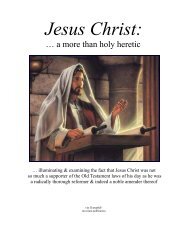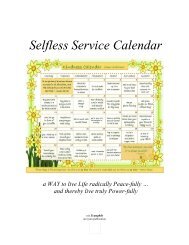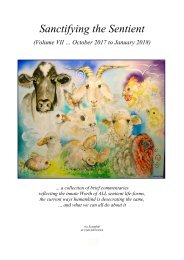Exhuming Easter (complete - 3rd edition)
Harmonizing the six Biblical accounts of the last days of Jesus Christ, and reinterpreting the implications of the same
Harmonizing the six Biblical accounts
of the last days of Jesus Christ, and reinterpreting the implications of the same
You also want an ePaper? Increase the reach of your titles
YUMPU automatically turns print PDFs into web optimized ePapers that Google loves.
Jesus’ Noble Intentions …<br />
For starters, in order to be able to better comprehend the alternative explanation of the<br />
“Resurrection Story” that will follow, let us briefly review what Jesus’ ministry was all about – let us<br />
review just what it was Jesus was trying to accomplish during the few years before his crucifixion.<br />
*First of all, it is important to remember that Jesus was a devout Jew from beginning to end. In<br />
Matthew 5:17-19, Jesus makes it very clear that he came to reform Judaism, not to create a new religion<br />
– “Do not think that I have come to abolish the law or the prophets; I have not come to abolish but to<br />
fulfill” (with the Greek word translated here as “to fulfill” actually meaning “to hone” or “to purify” or<br />
“to make perfect” … see also Matthew 23:2, Luke 16:16-17, John 1:17, John 2:19, John 8:6-8, John<br />
9:28-29, et al) … In doing so, Jesus frequently interpreted Jewish laws more strictly than their traditional<br />
renditions (see Matthew 5:21-28, 5:31-48, Mark 10:20-22, Luke 11:42, 16:10 & 18:22), and sometimes<br />
made harsher conventional laws more open-ended (see Matthew 12:1-13, Mark 1:17, 2:18-20, 2:23-28,<br />
3:1-4, 7:1-13, 10:2-9, Luke 5:31-32, 6:1-6, 6:37, 11:37-40, 13:12-17, 16:10, & John 7:23).<br />
Indeed, even Jesus' two greatest Commandments were mere reiterations<br />
of the Jewish Law of his day (see also Matthew 13:52 & Mark 2:21-22, 13:2,<br />
Luke 5:36-39, et al) – with his first Commandment being an adaptation of the<br />
Sh’ma of Deuteronomy 6:5, and his second Commandment being a direct<br />
quotation of Leviticus 19:18 (see Matthew 22:37-40, Mark 12:29-31 & Luke<br />
10:27-28). It is also interesting to compare these verses in Matthew with the<br />
oral tradition of Rabbi Hillel, who said, “What is hateful to you, do not do to<br />
your brother. That is the whole Torah; the rest is mere commentary … Go and<br />
learn it.” (Talmud Shabb, 31a).<br />
*Secondly, it is important to remember that Jesus’ ministry began and ended as a radical<br />
religious reform of the conservative Judaism being practiced in his time. His first major reform centered<br />
on the forgiveness of all sins. In opposition to the oral tradition of the Jewish culture, which had God<br />
only forgiving sins against God (Mishna Yom 8:9), Jesus taught that, “The Son of Man [i.e. each &<br />
every human being] has the authority on earth to forgive sins.” (see Matthew 9:6, Mark 1:10, Luke 5:24,<br />
et al) … His second major reform focused on exuding a purposeful & merciful Kindness towards all<br />
things “evil”. In opposition to the Hebrew Bible, which noted that we were to “burn the evil out from<br />
our midst” (Deuteronomy 17:7 et al), Jesus taught “Do not resist an evildoer. But if anyone strikes you<br />
on the right cheek, turn the other also … Love your enemies and pray for those who persecute you.”<br />
(Matthew 5:39+44, Luke 6:27-31+35-36, et al – see also Luke 10:29-37 & John 4:7-15) … His third<br />
major reform noted that the only Way to Salvation was “through him”. In direct opposition to the<br />
Psalms which noted that “God is near to all who call unto Him” (Psalm 145:18 et al), Jesus taught<br />
instead that “God did not send the Son into the world to condemn the world, but in order that the world<br />
might be saved through him” (John 3:17 – see also John 10:9, John 14:6 & Luke 12:8-9) – where “the<br />
Son” was not Jesus arrogantly referring to himself in the <strong>3rd</strong> person (see Mark 10:18), but rather<br />
referencing and encouraging all of humanity thereby (see also John 15:2-5, et al).<br />
[NOTE: It is very important here to recognize & understand the critical distinction between Jesus’ use of<br />
“through” in this verse, in marked contrast to the Psalmist's use of “call” – making it clear that Jesus was NOT<br />
saying that he was the only Son of God, as much as he was saying that The Way he was teaching had to be an<br />
active caring for others, as opposed to merely a verbal &/or mental form of worship (see Matthew 19:17-21,<br />
John 13:17, et al – and see also John 1:7, where “through him” is also used with regards to John the Baptist)]<br />
43


















